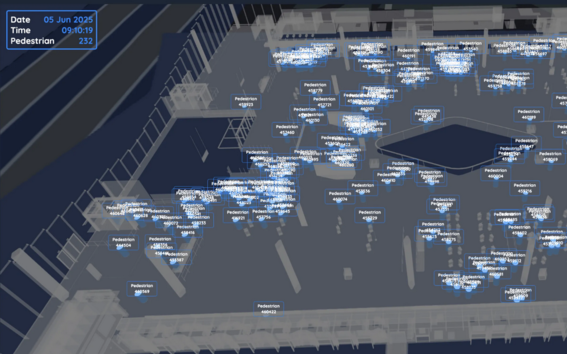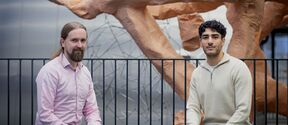Laser scanning reveals congestion and bottlenecks at the airport

The screen shows the departure hall of Helsinki Airport from above. The check-in desks and kiosks as well as the conveyor belts at security control stand out as simple shapes. Blue blocks move in the hall, forming clusters at the check-in desks. Eventually the blocks, moving at varying speed, advance towards security control.
The image is a digital twin, a real-time copy of the congestion in the departure hall. It is generated by a laser-scanning technique that utilises LiDAR sensors installed in the hall. The blue blocks are people moving around in the hall, while the clusters represent queues. Individuals cannot be identified.
This is a study investigating the movement of people flows conducted in the Untangling People Flow consortium. The project, coordinated by the University of Helsinki, has several collaboration partners, one of which, Flow Analytics, oversees the LiDAR sensors installed at the airport. During the year-long measuring effort, terabytes of data will be generated by people’s movements in the departure hall.
Easier queueing in sight
The project models human movement to make people flows increasingly smooth. The researchers will use the data to develop algorithms that identify regularities and irregularities in how people move.
“We statistically analyse the data and aim to identify congestion periods as well as patterns by day, month and, for example, holiday season. We use machine learning techniques to model these temporal patterns,” says Senior Researcher Andrew Rebeiro-Hargrave from the Department of Computer Science, University of Helsinki.
Based on the accumulated data, it is technically possible with this method to build a recommendation system and optimisation methods for airport services.
“In the future, for example, it might be possible to create a model that would provide an up-to-date recommendation on when to arrive at the airport in order to avoid long queues,” says Rebeiro-Hargrave.
Groups and those going the other way have an impact
Besides waiting times, the project focuses on people’s interaction with airport services. Rebeiro-Hargrave talks about microservices, such as check-in kiosks, escalators, baggage drop desks and security control queues for different traveller groups.
“Interaction with these services does not take place in isolation, as stress, among other factors, affects travellers’ behaviour and movement.”
What laser scanning images actually show is the complexity of the departure hall as a shared space, with even small factors affecting the smoothness of movement.
“Not everyone necessarily travels in a straightforward line to security control. Instead, there are people seeing off loved ones and walking against the general flow. Some travellers are in a hurry, others have time to linger. And large tourist groups can significantly affect people flows,” says Rebeiro-Hargrave.
Smooth, safe and economical
From the perspective of research, laser scanning at the airport opens up new dimensions for investigating people flows.
“This is a rapidly developing field that combines the internet of things, real-time data analysis and information provided by digital twins on how people interact with the built environment,” Rebeiro-Hargrave says.
Combining the data from LiDAR sensors with modelling carried out on physical spaces allows researchers to analyse the context as well: the reasons for queues, wait durations in specific areas, and the physical or behavioural factors that slow down or speed up flows.
“The ability to predict people’s movement makes it possible to improve safety, security and overall efficiency at underground stations, airports and other traffic hubs.”
Rebeiro-Hargrave points out that human flows also have an impact on the economy. If you are too busy at the airport, you don’t have time to visit the café.
This news item was originally published on the University of Helsinki website on 11.6.2025
Read more news

How to ensure anonymity of AI systems?
When training artificial intelligence systems, developers need to use privacy-enhancing technologies to ensure that the subjects of the training data are not exposed, new study suggests.
Arto Hellas receives the Nokia Foundation teaching recognition award
Arto Hellas was awarded the inaugural Nokia-OKKA Educational Recognition Award for his long-term efforts in advancing ICT education.
Elites wield huge influence over deepening polarisation –– now we can tell exactly how much
Just a handful of influential voices may be enough to drive dramatic societal rifts, according to new research from Aalto University. The study gives unprecedented insight into the social media mechanics of the partisan divide.